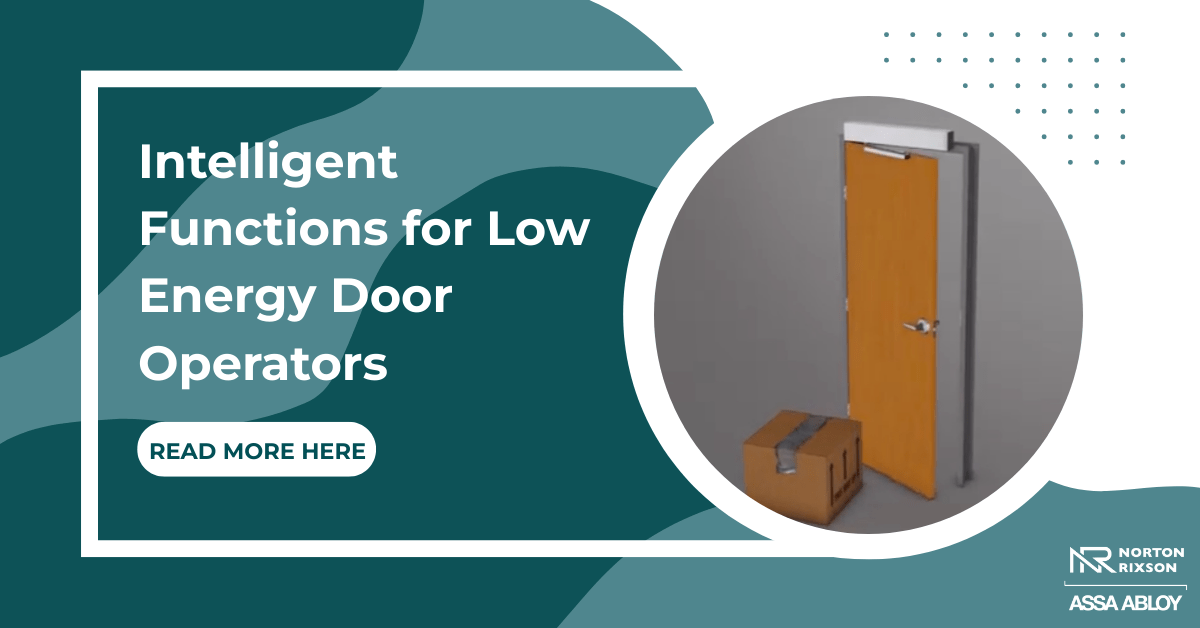Intelligent Functions for Low Energy Door Operators
Low-energy door operators are designed with a number of intelligent functions to deliver important usability and safety benefits across four categories: power assistance, obstruction detection, hardware help, and life safety.

Are you in the market for a low energy door operator? These electronic devices increase accessibility because they allow users the choice to open a door automatically or manually.
The Norton Rixson low energy door operators have been designed with a number of thoughtful features. These smart accessories deliver important usability and safety benefits across four categories: power assistance, obstruction detection, hardware help, and life safety.
1) Power Assistance
Push and Go – Opens the door to the widest open position.
The operator senses when the door is pushed manually and then takes over opening on behalf of the user. This is helpful for heavy doors or whenever people need extra opening support.
Power Assist – Provides an extra boost in opening power.
When it detects the door is opened manually, the operator applies a small amount of opening power to assist the user. A person will need to push with no more than 5 pounds of force. Great for heavy doors in schools, healthcare, assisted living, and hotels.
Power Close – Delivers an increase in closing force between 2 and 7 degrees.
This feature enables the door to properly close, latch, and seal. Useful for any opening that needs to overcome stack pressure, weatherstripping, and other environmental factors.
To see these features in action, check out our operator functionality video series!
2) Obstruction Detection
Presence Detector Input – Senses an obstruction and halts door movement.
This sensor can perceive objects, like a box or person, before it begins to operate. It keeps the door in an open or closed position so it won’t knock into the blocking item.
Obstruction Detection – Reverses door direction if it collides with an obstruction.
This is to avoid impact damage to the door, its operator, and the object. The door will close if the obstruction is in its opening path or open if the item is in its closing path.
3) Hardware Help
Open Delay – Delays the opening so the lock mechanism has time to retract.
Available in a 1-10 second delay, this option prevents the door from opening before the locking hardware has released. The activator is placed at a distance that allows for a user’s travel time to match the opening delay.
Latch Assist – Power bump at closing to ensure the latch has enough force.
This function helps overcome issues with stack or positive pressure from HVAC.
Infinite Hold Open – Keeps the door in a hold open position indefinitely.
This is an advantage during times of high traffic, moving large objects, or maintenance.
Adjustable Hold Open – Program how long a door should stay in the hold open position after an activation.
This is a customizable feature that allows you to account for your building’s unique needs, such as a population with limited mobility or frequent deliveries.
4) Life Safety
Emergency Interface Relay – Closes the door when the fire alarm system is active.
By ignoring input from activation sensors until the fire alarm is off, this feature helps direct people away from areas of danger. Does not prevent exit, only discourages entry.
Blow Open – Opens automatically for smoke ventilation.
The fire or smoke alarm system triggers the door to open. This has the benefit of letting smoke out while fresh air can come in during an emergency.
Interested in learning more about our operators? Fill out the form below to get in touch with our team of experts.